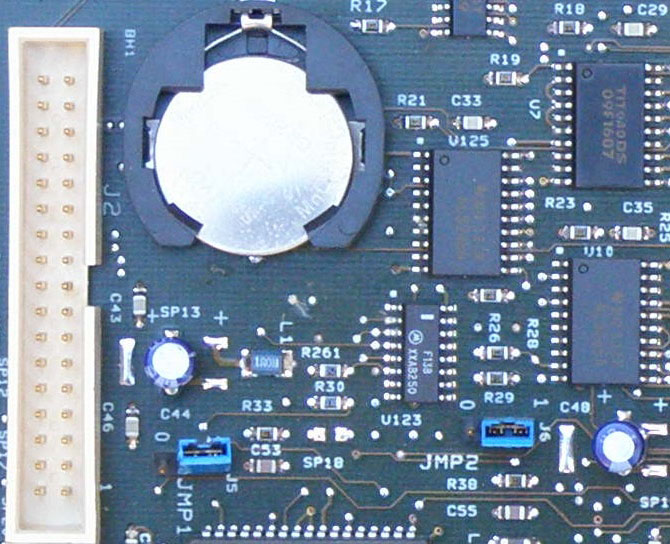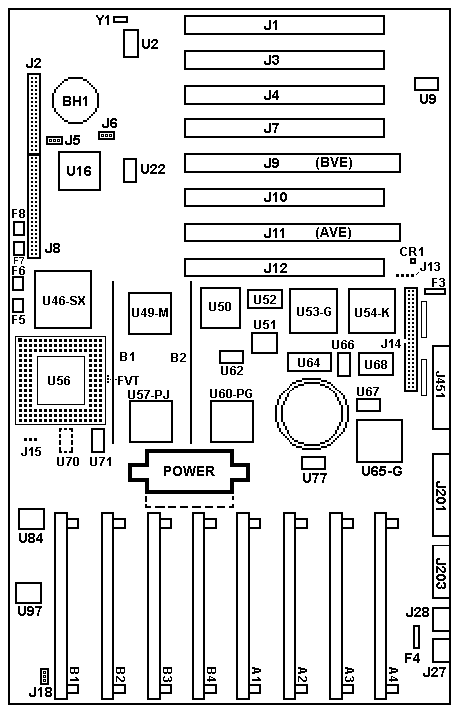|
rd9585a Diagnostic Diskette v1.11 1994-03-17 postbios BIOS Flash Update v1.11 1993-04-30 Needed to support ECC-P 192-224 IBM PS/2 Server 85 (9585-0X6, 0XA and 0XF) 193-207 IBM PS/2 Server 85 (9585-0XG) BIOS 1.10 9585-X Supports Display Panel! 9585-X Operator Panel Support Components, Front 9585-X Operator Panel Support Components, Back Adding Op Panel Support to 85-K by Major Tom Onboard SCSI Maximum IML Drive Size X without IML Drive? ADF Sections 9585 X Planar 92F0270
U70 solder pads
for another oscillator. Possibly a different CPU speed?
Like 25MHz? J15 Three pin header marked "55" and "66" J13 is for
what??? FVT is what?
Small outline- Not big enough for a normal header. Not
sure. Maybe something to switch between an ODP and ODPR?
Need to test where the leads go... F5-8 PTC fuses on
the planar power traces (like 85-K/N and 95A planars). Dallas DS1485S RTC
Datasheet BIOS update 1.10 From Peter Wendt I don't know exactly how this "upgrade" works. It is not really a "Flash-BIOS" update ... it is more a diagnostic code upgrade and puts another xxx.BIO file on the harddisk. Most likely it loads during IML (while the 9585 *use* IML - disregard the fact that they have a flash-BIOS ... try running one without IML-partition ...) and I *think* it can be returned to the old level with using the other (old) code reference and diags disk and run "restore system partition" - but: I am not sure here. 9585-X Supports Display Panel! Major Tom Just checked, and the 85-X BIOS contains pretty much the same checkpoint routines as the later 90/95 T4 and 85-K/N SurePath BIOS. It outputs the CP codes to ports 108 - 10Fh as the other systems do, and the checkpoint routines are actually being called by the POST code. So if the planar logic indeed is there, you should see the CP codes on the Op Panel. Dangerous Dave [Beem] Confirmed - I have a spare panel displaying information when I did nothing more than unplugging the speaker/power switch board and plugged it in. 9585-X Planar close-ups from David Beem. 9585-X Operator Panel Support Components, Front  U123 [74F138], U125 [74ALS245], and R261 [10 k Ω, pkg #0805] are populated. 9585-X Operator Panel Support Components, Back  R262 [100 Ω, pkg #0805] and R263 [30 - 70 Ω, pkg #0805] are populated. The PS/2 Server 85 (announced Sept 21, 1992) was to replace the PS/2 Model 80. Features EE Floppy Support Memory The 85-xXx supports a maximum of 64MB of parity memory. All 64MB is addressable by DMA. 2MB, 4MB and 8MB 70ns parity memory SIMMS are supported. Mixed SIMMs Permitted
What is ECC-P?
For more on this fascinating subject, go HERE ASCII Terminal The IBM PS/2 Model 85 contains a console select utility that allows systems console operations to be performed by an ASCII terminal via the system asynchronous communications port (serial port) pre-installed on the system hard disk. If this option is selected, an ASCII terminal must be connected to the serial port at the time of selection. Onboard SCSI From Peter Wendt The onboard SCSI of the 95xx is often referred as "Spock-Prime" - and is (almost) identical to the later SCSI with cache ... with the exception of the cache, which it hasn't got. From the design it is *very* similar to the short SCSI without cache, which has an 80C188-16 as well. The SCSI microcode however is part of the machine BIOS stored in a single small 16-bit PLCC EPROM if I remember correctly. There is a part of the SCSI code also included in the IML. This adapter can be found on the 9556/9557, the "Bermuda" 9576/9577 - and the "small" 9585-0Xx. If you look closely at the 9585-xXx planar you will find some SMD transistor "of the bigger kind" and some stuff that looks like "auto-termination". In addition the onboard SCSI adapter of the "Spock-Prime" is described as "SCSI-2 compliant" ... which extends on the command set in the first place, the enhanced SCSI translation and on the electric interface as well I think. But not on the speed of course, which is 5 MB/s SCSI-1 standard. David Beem elucidates: Although the newer BIOS image (for lack of a better term) wouldn't update the SCSI microcode, it may change the "ROM BIOS Extension" SCSI code to give larger hard drive support. What is the difference between the two? Does the splash screen or anything in the system setup change? Maximum IML Drive Size Uh ... more related to the
short SCSI w.o. cache - but nonetheless limited to
<1GB IML drive. They must have used the old microcode
and the BIOS doesn't support it either. There was a POST BIOS upgrade available
for the -xXx - which screws the -xNx and -xKx to crap.
But as far as I recall it does not change this
misbehavior. I had that back in '94 or so: customer
wanted bigger HDs and bought 1.08GB DPES ... installed
IML - seemed to work until you'd switched off and
cold-started the -0XA. After that you got an IML-error. No Way. IBM confirmed that the -xXx is not over-1GB capable. Only way to leave a smaller IML HD in the machine. Return Fire William Walsh hitches up
his gun belt and drawls: I tried a 60GB Seagate SCA disk in one of them. OS/2 Warp 4 saw it properly, system programs showed a negative number value, somewhere around -15GB IIRC. Of course, I just had to LLF the drive...and that diddled it. I've tried a lot of things but haven't gotten that drive going again. X Without IML Partition?
[Ed.
if it is akin to the Type 4 based systems, then it might
be able to lay and use a convenience partition on drives
up to the 8GB limit] ADF Sections AdapterId FFDC 9585 X Planar Serial Port Parallel Port Parallel Port DMA Arbitration
Level SCSI Address (ID) SCSI I/O Address select
SCSI Fairness On/Off
SCSI DMA Arbitration Level
ADPItem 1 Alternate Processor
ADPItem 2 Current System Speed
ADPItem 3 Memory-Checking
Method Note: If a bad-battery error (161) or a configuration-integrity error (173) occurs, the configuration will be reset to use the parity-checking method. |
